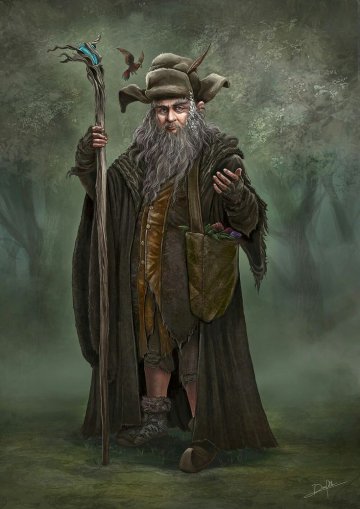
Q: Who Is Radagast the Brown?
ANSWER: Radagast the Brown wizard is a character in The Lord of the Rings whom Gandalf identifies as a member of his order, the Istari. The Istari were a group of angelic spirits sent to Middle-earth by the Valar (Iluvatar’s emmissaries) to assist Elves and Men in resisting the power of Sauron, the second Dark Lord.
Radagast is mentioned in The Hobbit but he plays no part in the story. Gandalf says to Beorn that his “cousin” Radagast lives near the southern border of Middle-earth. Beorn mentions having seen Radagast from time to time and holds Radagast in good esteem.

In The Lord of the Rings Gandalf relates to the council of Elrond in Imladris that Saruman, leader of the Istari, had sent Radagast to find Gandalf to convey a message to him from Saruman. Radagast and Gandalf met up along the Greenway, an ancient highway running north and south past Bree. After delivering his message Radagast left the area, but Gandalf asked him to arrange for his friends among birds and animals to gather news and send it to Gandalf (and Saruman) at Isengard, the fortress where Saruman lived.
Although Gandalf was betrayed and imprisoned by Saruman Radagast remained faithful and in time the great Eagle Gwaihir the Windlord brought tidings to Gandalf at Isengard. Gwaihir rescued Gandalf and took him to Rohan. There is no further mention of Radagast in the story.
In notes written sometime after the composition of The Lord of the Rings Tolkien suggests (to himself) that Radagast may have remained in Middle-earth after Sauron was defeated, either because he finally succumbed to the temptation of establishing himself in Middle-earth or because he had some further purpose. Tolkien does not seem to have ever resolved Radagast’s ultimate fate.
Radagast’s name has been the subject of much debate and controversy. In an essay titled “Istari” J.R.R. Tolkien wrote that Radagast is an ancient Adunaic (the language of the Edain) name meaning “tender of beasts”. In Valinor he had been known by the Quenya name “Aiwendil” (devoted to birds).
In historical languages, the name Rada is Slavic and means “happy”. Radegast is the name of a Slavic god of hospitality, fertility, and crops. Alternative spellings include Radogost, Radigast, and others. However, there is a strong etymological connection to English rede (“advice”, “counsel”) and its cognates in Old Germanic and Old Norse, including Radha in the latter. The word gast in Old English could be used of a ghost, spirit, angel, or demon. Hence, Tolkien may have used the name Radagast in the sense of “wise or counseling spirit/angel”. This latter usage is more consistent with Tolkien’s Old English influences, especially considering that many of the names in The Hobbit (including Gandalf, Beorn, and Bard as well as the names of the Dwarves) are borrowed from Old English or Old Norse.
Radagast is said to have lived near the borders of southern Mirkwood, south of the Great Forest Road and close to the Gladden Fields, at a place called Rhosgobel. The name is Elvish (Sindarin or Silvan adapted into Sindarin form) and is defined by Tolkien as “brown hay”. Tolkien uses “hay” to describe defensive hedges in several of his stories, including tales from The Silmarillion and related works. The Hobbits of the Buckland raised the High Hay to protect their land from the trees of the Old Forest. The Edainic town of Amon Obel in the forest of Brethil is another settlement defended by a protective hedgework.
There are references to individual estates or farmsteads that are protected by hedges (including Beorn’s house) so we cannot deduce from Rhosgobel’s name whether it was a town or a lone dwelling, but the etymological evidence and Beorn’s acquaintance with Radagast suggests he may have played a role among the Men (and Elves) of the Vales of Anduin similar to that role played by Gandalf in Eriador and Saruman in Gondor and Rohan, as a friend and advisor to local free peoples. (NOTE: See “Horror in the Woods — How Men Live in Mirkwood” for an exploration of how Rhosgobel might have looked.)
A lone reference in the essay “Of the Rings of Power and the Third Age” says that the White Council was formed by the Lords of the Eldar and the Istari. This may mean that Radagast played a role on the council. The fact that actor Sylvestor McCoy has been cast as Radagast in Peter Jackson’s “Hobbit” movies may mean that he will be depicted in scenes dealing with the White Council, or perhaps in background events relating to either Beorn or the events leading up to the War of the Ring.
See Also:
What Happened to Radagast the Brown after the War of the Ring?
Why are Saruman, Radagast, and Galadriel in the Hobbit Movies?
# # #
Have you read our other Tolkien and Middle-earth Questions and Answers articles?
